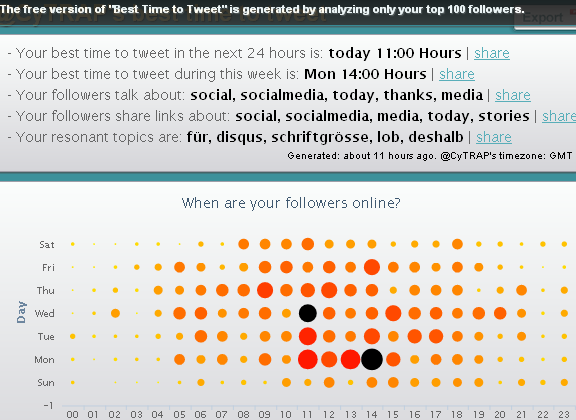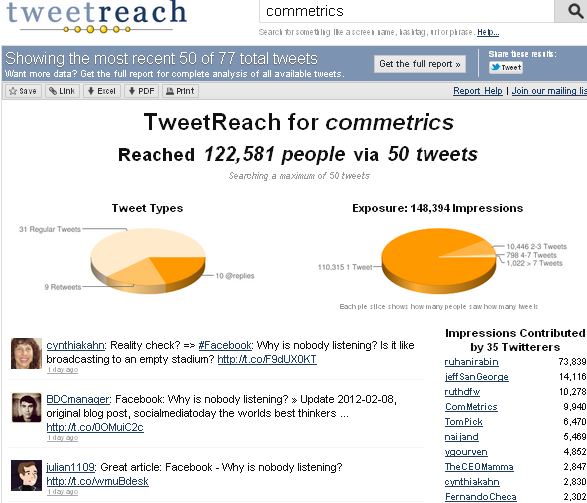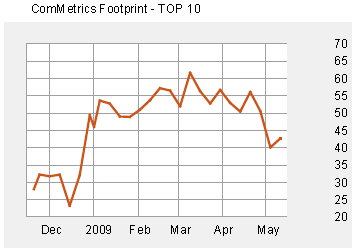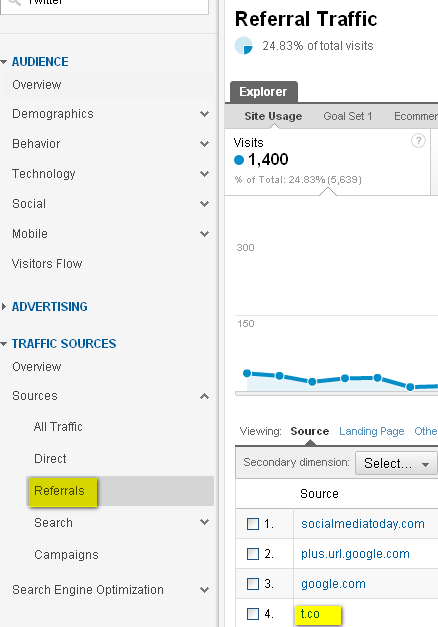We published a post about the 101 best Twitter tools, saving time with Twitter but how can we best measure our impact and resonance on Twitter?
We tested the best and the worst and present our four winners, guaranteed to help you achieve a bigger bang for your buck.
Since I began blogging in late 1999, I am continually discovering amazing things. In the process, I have also given a lot of thought to how social media works. This makes me wonder whether Twitter and other microblogging tools matter, and if so, do they help you scale your efforts and generate improved resonance for your work and tweets (Is social media un-social? 6 keys to success)?
Of course, social sharing means we must make meaning, not just buzz – make money, not just web traffic.
I thought you might be interested in reading about some of my experiences, and I would appreciate your help in curating this list by providing additional details and submitting further cases. Here are some analytics I recommend you use.
1. The Archivist
The Archivist was built by Mix Online, which I am told is a group of somewhat opinionated designers and developers at Microsoft. While this is still in alpha or beta, depending whom you talk to, you can use it to get information. For instance, if you produce a hashtag # for an event, such as a conference, like #ComMetrics12, the software will help you gather information about:
- the top users of this hashtag
- the top words tweeted
- the top URLs tweeted
- the tweet vs. retweet (or RT) ratio
- the sources tweets are sent from (tools like Tweetdeck or web browser), and
- all of the above over a period of time (i.e. before, during and after the event)
Here is an example I created for Swiss Internet Marketing Day 2012… very useful, no?
With me so far? Then join our over 5,000 subscribers if you have not done so already by entering your email and get the trends and tools first.
[subscribe2]
Bottom line: This is a useful tool when organizing an event and using an official hashtag.
Check it out! More tools in the full post below.
2. Tweetstats
This one can be summed up as colorful graphs of your Twitter life. Nevertheless, it will render your tweet timeline as a nice bar chart, showing your activity since you started.
Comparison between Jeremiah Owyang @jowyang versus Urs E. Gattiker @ComMetrics – and the winner is?
TweetStats provides a nice overview of overall activity, including tweet volume and density plus aggregate daily and hourly tweets. I find the tweet timeline particularly interesting because it shows that my daily average number of tweets has dropped from about 4 to about 1.8.
Bottom line: Useful tool that you might want to use once every two months to watch the trends.
3. Social Bro
Social Bro is a bit different than TweetStats, allowing you to visualize statistical information about your followers and friends.
The tool also shows the people who are no longer active or do not follow you. Some information, such as which famous Twitter user is following you is navel-gazing type stuff, since there is no way of knowing how it was calculated – what criteria does Social Bro use to decide somebody is a ‘famous’ Twitter user?

We also do not know how the top 100 followers were chosen (i.e. I could not find information about this on the website… have you?). What is important in the second graph are the black and red dots that indicate when followers are online, and most importantly, whether they re-tweet or reply to my tweets.
Most times I tweet at 07:00 (UTC+1) to catch the Europeans who check incoming tweets on their way to work. In some cases they take my tweets and include them as part of their daily paper.li edition or store.it, to mention two examples.
Of course, then they tweet about their ‘daily newspaper’ being posted, probably mentioning @CyTRAP (where I tweet in German), if they took one of my tweets and posted the information. After receiving the above statistics I tried tweeting later in the day to see if it would positively impact my number of re-tweets or replies. Unfortunately, I got fewer clicks on my shortened links.
Bottom line: Find a time to tweet when most of your audience can see it. No, this does not necessarily mean they are online (e.g., whilst at work), because they may not have time to read your tweet then. Do not trust a chart like the one above. Make your own assessment and put things in context.
Download Social Bro’s analysis for CyTRAP on Twitter – interesting, but be careful!
4. Google Analytics
Google Analytics is a common metric tool, assuming you have it installed on your site and have access to the reports. In turn, you can use it to help you determine how effective Twitter is at driving traffic.
As you can see above, clicking on Traffic Sources on the left, then on yellow-highlighted ‘Referrals’ shows a list of sites referring traffic.
t.co is the URL shortener Twitter changes most other URL shorteners to (e.g., bit.ly, su.pr and goo.gl).
Clicking on Advanced Segments also allows you to enter Twitter as a keyword to be used in a search. You can even add special Twitter account names such as @ComMetrics to see how much traffic these accounts bring to the website.
Of course, we must remember that this information depends on the person doing clicking also having cookies or javascript enabled. Google explains this under Tracking Methods:
Cookie-based tracking relies on a browser setting the cookie. If cookies are disabled, cookie-based analytics programs (such as Google Analytics) will not count the visit. This would exclude, for example, hits from a robot or spider. (Emphasis mine.)
Bottom line: Most visitors from corporate networks will have cookies disabled (e.g., banks or insurance companies), so Google Analytics will completely miss their visit. C’est la vie. In our case, this applies to 40 percent of visits or more. How do we know? Because we use server-side statistics that count visits whether cookies or scripts are active or not.
Cute, but do I need it?
Twitaholic, PeerIndex and their ilk offer various metrics for users of social media site Twitter. Some offer a little more than others, some very little at all.
TwitterCounter. You can produce your own graphs for up to three different twitter users, see the number of followers and past tweets for up to three months for free.
TwitGraph. This produces a number of different graphs, including tweets per day over the last week and top words used in your tweets.
Tweetings. Based on the same open-source Twitter extension as Silver Bird (formerly Chromed Bird). While they are similar, Tweetings’ design is a bit more appealing.
tweetreach. Another tool that provides information about your recent tweets, etc. Again, what you do with this information is up to you (see below for @ComMetrics).

TweetsBetween. This program allows you to see how two users tweet with each other. Interesting, but not that useful for most of us.
TwitterMap will show you who is tweeting any keyword such as #ComMetrics or who re-tweets one of your tweets like RT @ComMetrics by pinpointing them on a Google Map.
TweetGrader from Hubspot was offline for a while but is back now. The tool gives suggestions on how to improve one’s Twitter performance. It is nice, but not earth-shattering. Worst is that it fails to tell you how it calculates your influence. A bit hard when you report to the budget committee.
Notice anything missing? Please leave a link & description to the tool we missed below, I will add it.
What should you do now?
Check out the four tools above and see how you can make use of them, BUT ALWAYS REMEMBER, measuring just to measure is useless. Stop the navel-gazing and focus on your direct followers. Get them to click on the URL shortened links you tweet.
There are too many examples of companies and bloggers who have wasted resources in an attempt to create Twitter conversations while ignoring the bottom line: know your customer.
More information about Twitter tools – measure for impact
– What makes a baseline review effective?
– The social business maturity model
– Suggestions made in a Quora discussion about Twitter metrics
– 101 best Twitter tools
– Tweets for my tweets
– Trending tweets with Twylah
:: Premium Intelligence :: find out if your blog posts have a ripple effect on Twitter ::


Please register => improve your blog’s impact using Twitter
Are you with me on these trends? Please share your thoughts below (click to write)!
TL:DR
@ComMetrics 2012 marketing trendwatch – Twitter metrics: The ultimate tools | Please – tweet this
do not get a response (e.g., reply, re-tweet, etc.) –
Followers cannot keep up with all those tweets.
Yes, it will get worse and may never get better. OUCH!
Tip: Search for more ComMetrics and CyTRAP sources on Twitter tool(s), impact, resonance and branding (click to query).
Tools that are offline for now!
TwitterAnalyzer is currently unavailable, but shows graphs and data on Tweets, chats, popularity and reach when it is online.
The author: This post was written by social media marketing and strategy expert Urs E. Gattiker, who also writes about issues that connect social media with compliance, and thrives on the challenge of measuring how it all affects your bottom line.
His latest book, Social Media Audit: Measure for Impact, is scheduled to appear from Springer Science Publishers in Summer, 2012.
Connect with the author using: Email | Twitter | Google+ | Xing


Pingback: World Economic Forum
Pingback: Chris Isaac
Pingback: World Economic Forum
Pingback: Stephen Trask, MT
Pingback: NPapendorf
Pingback: Julian O.
Pingback: Hailey Dale
Pingback: Ernest Spencer
Pingback: Katharine Norwood
Pingback: Russ
Pingback: blufrogger
Pingback: Todd Robinson
Pingback: John Macy
Pingback: Jay F Nelson
Pingback: Dawg Bone
Pingback: Dawg Bone
Pingback: Connie Maybree【ツ】
Pingback: Connie Maybree【ツ】
Pingback: Connie Maybree【ツ】
Pingback: Carl Norman
Pingback: Carl Norman
Pingback: Carl Norman
Pingback: John Acheson
Pingback: Kind Canine
Pingback: Richard E. Byrd
Pingback: John Macy
Pingback: affiliatebuck10
Pingback: JJ Smith
Pingback: CyTRAP
Pingback: Tweeters Tools
Pingback: Ralph Scholze
Pingback: Tone
Pingback: Brent Purves
Pingback: Twit Agency
Pingback: Melonie Dodaro
Pingback: Horizon
Pingback: Walter Adamson
Pingback: Kate Nelson
Pingback: Jeanette DesJardins
Pingback: CRANK IT Media
Pingback: Aaron Mann
Pingback: ResolutionMediaGroup
Pingback: Write Social Media
Pingback: Chris Kanski
Pingback: WEB
Pingback: Andrew Tully
Pingback: R4BIZ
Pingback: Love 4 Social Media
Pingback: Love 4 Social Media
Pingback: adrienne sender
Pingback: Salina Washington
Pingback: SocialMediaInfluence
Pingback: Jonathan Mast
Pingback: Gerry Grant
Pingback: Inbound Mrktg Agents
Pingback: Social Media Studio
Pingback: Jon Simon
Pingback: Social Media Mgmt.
Pingback: Alex Hall
Pingback: Anise Smith
Pingback: CyTRAP
Pingback: Tastebuds
Pingback: Tastebuds
Pingback: Habla Consulting